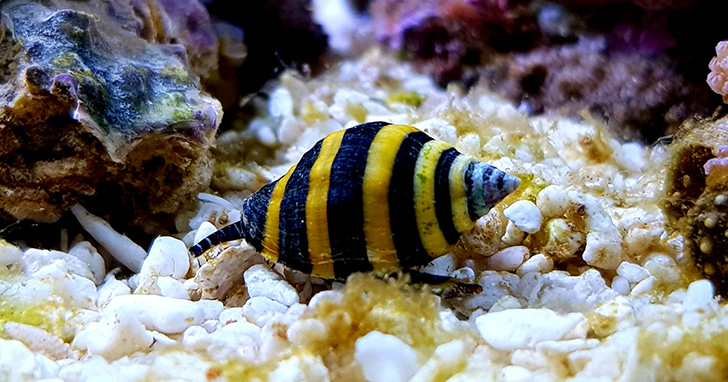
Nano Inverts:Small Cleanup Crews for Big Impact If you think that your nano aquarium is too small to support invertebrates, think again. Small marine invertebrates can make a significant impact by consuming algae and detritus, helping to maintain water quality and balance in your aquarium. In addition, they are fun to watch and will help provide stability to aquarium water. How many inverts should I add to my nano tank? After you have made the decision to introduce invertebrates into your marine nano aquarium, you will need to be mindful of how many to add. Though little, invertebrates with huge algae eating appetites can deplete the algae in your aquarium, and if there is not enough algae present to support all of the cleanup crew members, they can starve themselves if they are not given supplemental food. Reef hobbyists should also be sure that the water, lighting, filtration, waterflow, and safety needs of these invertebrates are being met. With research and care, you can begin to enjoy the benefits that healthy specimens add to the diversity of your home aquarium. Can I add inverts to a new aquarium? Hobbyists should be sure to follow recommended acclimation procedures using the Drip Method. Also, the invertebrates should be added to the aquarium at the correct time in the setup process. For help with setting up a reef aquarium, refer to the handy LiveAquaria® article Step by Step Reef Aquarium. It is important to add invertebrates to an established aquarium in which algae has had time to accumulate. What species are compatible tankmates for small inverts? Aquarists should be diligent in selecting fish tankmates that are housed with invertebrates and should avoid adding fish that will eat small invertebrates. If housing corals, the invertebrates should be reef safe so all species can live together safely. What are popular reef invertebrates?
Let's find out a little more about these recommended species. Are Bumblebee Snails good for nano aquariums? Bumblebee Snail Pusiostoma mendicaria Bumblebee Snails have a distinctive yellow and black shell that adds a splash of color to reef or saltwater aquariums and can be an exciting addition, due to their algae and detritus eating activity. In addition, they will also consume troublesome bristle worms. Because of their small size, they can reach food in hard-to-reach areas between rockwork and other areas of the aquarium. They grow to one and one half inches in length and are reef compatible. This tiny member of the Buccinidae family burrows into the sand bed where it consumes sand-dwelling worms and helps aerate the substrate. The Bumble Bee Snail is a carnivore and may feed on other snails if there is insufficient food. If insufficient food sources are available, their diet should be supplemented with offerings of meaty foods including finely chopped brine or Mysis shrimp and frozen meaty foods. Is the Scarlet Reef Hermit Crab good for nano tanks? 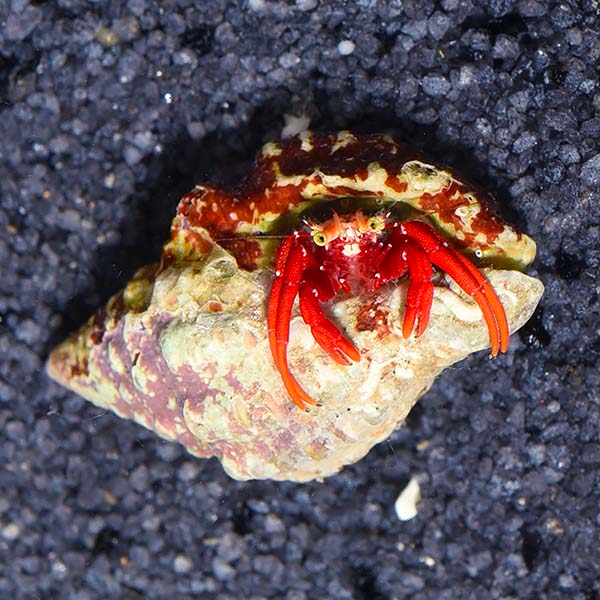
Scarlet Reef Hermit Crab Paguristes cadenati Overall, Hermit Crabs make good choices for saltwater aquariums, and particularly nano tanks, due to their small adult size of one and one half inches in length. The Scarlet Reef Hermit Crab is particularly decorative, sporting a bright red exoskeleton and legs, which help them stand out in a smaller aquarium. They are reef compatible and voraciously consume a variety of nuisance algae, particularly filamentous, hair and slime varieties, as well as cyanobacteria. If algae levels are insufficient, their diet should be supplemented with dried seaweed and other marine foods. Like other Hermit Crabs, an ample supply of empty shells should be available for the Scarlet Reef Hermit Crab to move into as they molt and grow. As with all invertebrates, they do not tolerate copper-based medications and extreme fluctuations in water parameters. What crabs are good for nano tanks? 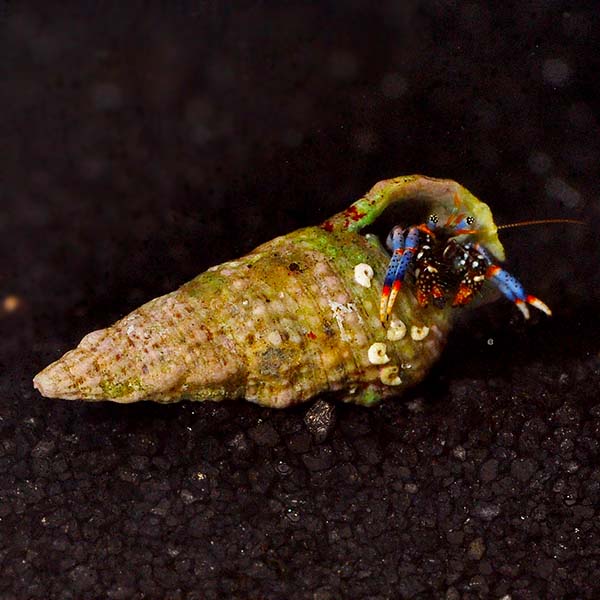
Dwarf Blue Leg Hermit Crab Clibanarius tricolor Dwarf Blue Leg Hermit Crabs are colorful invertebrates in an allover blue color with red bands across its legs. They are also social, so adding them in pairs is a good idea. Though this reef safe crab grows to only an inch in length, don't let the small size of the Dwarf Blue Leg Hermit Crab fool you. It is a voracious scavenger that can get into the smallest crevices and openings within live rock to consume nuisance algae including hair algae and cyanobacteria. While doing so, Clibanarius tricolor also helps aerate the sand substrate, thereby encouraging the growth and activity of beneficial bacteria. If insufficient algae is present naturally in its environment, supplement their diet with dried seaweed. Like other Hermit Crabs, aquarists should ensure empty shells are available for them or they may attack snails for their shells. What's a good shrimp to add to my nano aquarium? 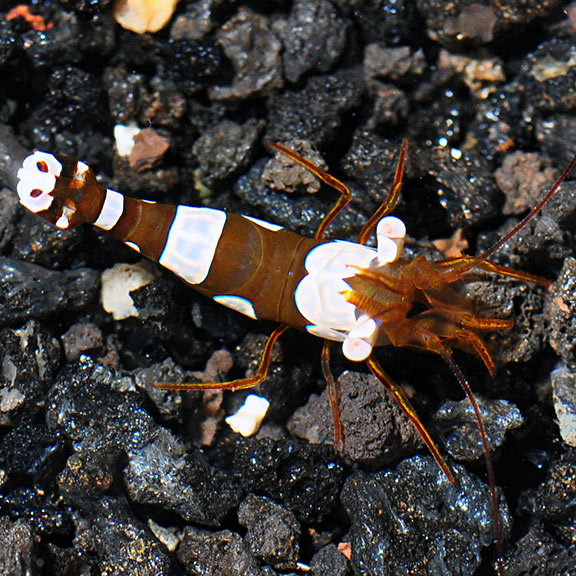
Sexy Anemone Shrimp Thor amboinensis The Sexy Anemone Shrimp is tiny, as it grow to about one half inch, but can make a big impact in nano saltwater and reef aquariums due to its striking appearance. With a reddish brown body that is dotted with brilliant white spots, it appears to dance as it walks, swaying its abdomen back and forth with exotic flair. In nature, they very often make their homes in the tentacles of anemones. In the home aquarium, however, the Sexy Anemone Shrimp is often found perched on a coral frag or outcropping of live rock. It should be fed a varied diet of plankton and flaked, frozen, and meaty foods and should not be housed in aquariums with predatory fish that might harm them. A relatively fast grower, it will molt about once a month. To promote proper molting, sufficient iodine levels must be maintained. Like other invertebrates, the Sexy Anemone Shrimp cannot tolerate high nitrate or copper levels. Can I add Pom Pom Crabs to my saltwater nano tank? 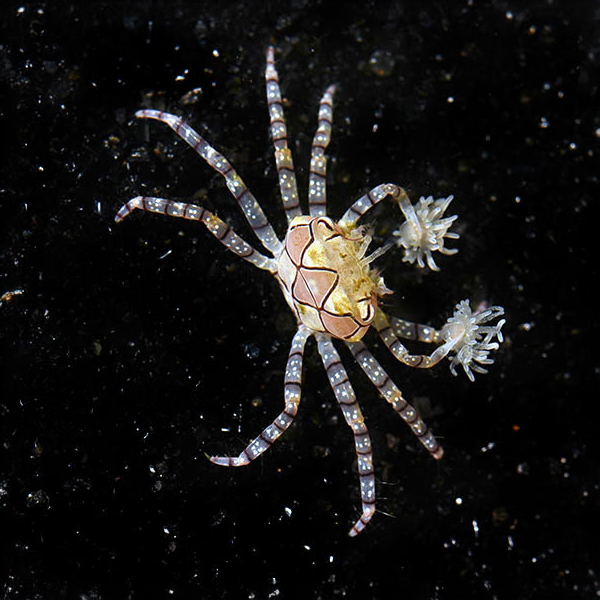
Pom Pom Crab Lybia sp. The Pom Pom Crab has a white to tan body color with darker markings covering the body that serve as camouflage. Its unusual look (and name) comes from the fact that it houses an anemone in each claw which it uses for defense. It makes an interesting addition to an aquarium and is ideally sized for nano aquariums, as it only grows to one inch. Caution should be used when adding this crab to a reef aquarium as the anemones can sting sessile invertebrates and corals. The diet of the Pom Pom Crab should include meaty foods such as Mysis shrimp, chopped fish and clams. What's an unusual invert for my nano tank? 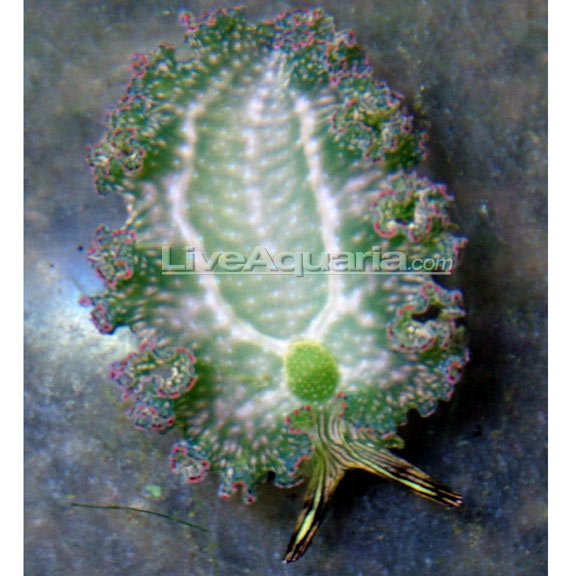
Lettuce Sea Slug Elysia sp. The Lettuce Sea Slug is an unusual and entertaining addition to the reef aquarium. Good for larger nano tanks of at least twenty gallons, this Sea Slug is reef compatible and grows up to three inches in length, and has highly folded parapodia (side appendages), which gives it a ruffled appearance similar to lettuce. The Lettuce Sea Slug is captivating not only for its interesting shape but also for the purposeful and comical manner in which it creeps along the reef aquarium. It can appear in green, yellow or brown colors. There is no distinguishing characteristic to help differentiate males from females. It does require the care of an aquarist with some experience, not lending themselves to a beginner care level. Elysia sp. will do well in an established aquarium system with ample room to forage and live rock on which it can graze for algae, with a particular fondness for hair algae. This marine invertebrate incorporates the chloroplasts (the portions of the cell responsible for photosynthesis) from the algae into its tissues and thus relies on photosynthesis for part of its energy. Pump intakes and drains can harm the Lettuce Sea Slug, so care should be taken to screen them. It is sensitive to high levels of nitrate and will not tolerate copper-based medications. They should not be housed with predatory fish. In Closing In addition to the species included here, there is no shortage of options when it comes to including invertebrates in a nano marine or reef aquarium. Nano aquariums are gaining in popularity because they add a bit of nature to your home environment. Similar to larger tanks, nano aquariums can accept small invertebrates that will add interest and cleanup benefits, too. With research and care, you too can have a diverse, healthy tank full of beautiful invertebrates that will delight you every day. Related Articles |
|
|


